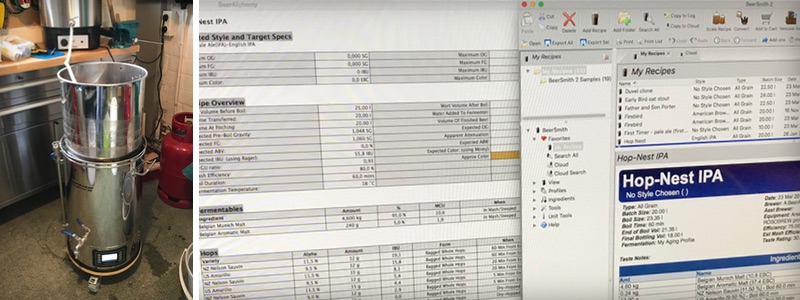
Hop Nest is a favorite of mine. It has the right amount of complexity while still being an easy drinker. The original recipe was an experiment with 100% Munich Malt paired up with some Nelson Sauvin and Amarillo for an English IPA. That beer went on to win the best of show in the first Vlaamse Hobby Brouwers Forum competition. Hop Nest was now going to serve as a calibration recipe for my new Arsegan EasyBrew system/process. After brewing Penelope, I had a good idea about the efficiency of the system, but the volumes were not correct yet (strike water, sparge water, boil off rate, etc.).
Not only was the EasyBrew new to me but I was also trying out some new brewing software. My normal software, Beer Alchemy, stopped getting updated. Plus, the only way I could find to factor in the large amount of deadspace under the grain basket in the Easybrew, was to play with the water to grain ratio. If all my beers were going to be around the same strength then that would be alright, but I want to brew stronger or weaker beers without having to play with profile settings. It was great for my previous Batch Sparge system, but with the EasyBrew it just didn’t cut it.
BeerSmith seems to be the current market leader for homebrewers, and it offers a lot more settings to play with than BeerAlchemy. So I created my next recipe in both applications. However, even in BeerSmith the volumes of water still weren’t adding up. Starting off I didn’t have a lot of confidence in either program. I don’t want to have to second guess volumes. I want to be able to create a recipe, then follow the directions in the app without having to think. When I think, I over think, and that doesn’t make my life any easier.
Calibration Batch 1 (April 8th 2018)
Hop Nest
- OG:1.056
- FG: 1.012
- IBU (Rager): 59.4
- ABV: 5.8%
- Final volume: 18 liters (1 corny keg)
Fermentables:
- 90.9% Weyerman Munich Malt
- 5.5% Flaked Oats
- 3.6% Crisp Maris Otter (was to make up for the fact that I accidentally didn’t order enough Munich)
Mashing and sparging: Single infusion mash @ 67°C for 60 minutes
As I started to mash in I realized that the mash was way too thick. After doing some quick math on paper (deadspace + water/grain ratio + grain absorbtion), I adjusted my strike water volume. Sparging was easy to figure out on paper too (sparge vol. = boil vol. – strike water + grain absorption). The rest was smooth sailing.
The EasyBrew can be fully programmed to go from step to step by itself without too much input from the brewer, but for these first brews I did not try that out. I wanted to have the freedom to quickly change the wattage depending on what I saw going on in the kettle ( I use the full 2500w to quickly go up in temperature but then only 1600w to 1800w to keep it at temperature).
Boiling:
- Nelson Sauvin (Whole leaf) 12.8%AA – 60 min. from end (21.4 IBU)
- Amarillo (Whole leaf) 9.3%AA – 60 min. from end (15.6 IBU)
- Nelson Sauvin – 20 min. from end (9.1 IBU)
- Amarillo – 20 min. from end (5.3 IBU)
- Nelson Sauvin – 5 min. from end (5 IBU)
- Amarillo – 5 min. from end (3 IBU)
- Nelson Sauvin – Dry Hop 1g/l for 7 days
- Amarillo – Dry Hop 1g/l for 7 days
Unfortunately, I forgot to adjust the Alpha Acid content of this harvest of Nelson Sauvin in BeerSmith. I didn’t see that until after boiling was almost done. It’s not a big deal but it means that the hopping will be a little bit off.
My boil off rate needs some work too. I have been playing around with the wattage and seem to have settled around 2000w for a decent rolling boil. However, it may not be vigorous enough. The flavors associated with a weak boil aren’t in my beers though. I am just a bit surprised that I’m only losing about 3 liters over 60 minutes. My previous system was 5 liters. More brewing needed!
Yeast: Safale US-05 (dry)
Beer was fermented in a plastic brew bucket @ 18°C (64.5°F) for 14 days before dry-hopping in the same bucket. That is 21 days on the yeast cake. It still surprises me that this works without giving off any off flavors, but it does. It definitely makes it easy! After dry-hopping, the beer was kegged into 2 of my 9.5L (2.5 gal) corny kegs.
How did it turn out?
The beer turned out really good. It did miss a bit of the crisp citrus and summer fruit hop character that I remember Hop Nest having. Is this because of my Alpha Acid mistake? I think partially yes. I also think that this past harvest of Amarillo just wasn’t the best. There were more harsher grassy notes than there should have been. Most likely from the Amarillo, but I don’t know for sure. The malt character was great. It reminded me why I love Munich malt in high percentages. It creates a much more complex malt character than normal pale malt. Bready and biscuity malt with a touch of caramel. I did miss a little bit of caramel complexity that usually I get from a small addition of a cara malt. The Flaked Oats did’t really add as much mouthfeel as I had expected, but it wasn’t as thin as that very first batch. It was still a great drinker!
My initial thoughts on the mash efficiency of the EasyBrew were confirmed (75% with the grain crush I am now using). The mashing profile in Beersmith has to be reworked though. The first profile was based on the Grainfather but I just couldn’t get the numbers to match with what I had seen on brew day. Back to the drawing board I guess.
